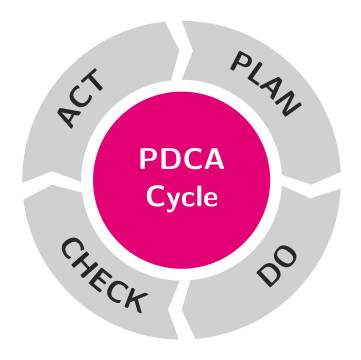Innovation Corner
Permanent link for A Model for Improving Your Business on March 31, 2023
Many businesses think of their biggest competitive advantage as being the "secret sauce" in their product or service. Established businesses often focus on their "core strengths," which invariably revolve around their main capital investments and maintaining a healthy ROA. In practice, though, a company's real competitive advantage is their ability to consistently adapt and improve how they do business.
Startups, as temporary organizations dedicated to the search for a repeatable and sustainable business model, do this constant improvement almost instinctively; there is no "right" way to do things, so entrepreneurs are always looking for some way to do things. One of the key steps in transitioning from startup mode to normal business mode is setting up the organization to continue to learn, adapt, and improve.
This is accomplished in four steps:
- Set up processes and tools that everyone can follow, then
- Make sure people follows the processes,
- Compare the results to what was expected and understand the causes for any deviation from expectations, and
- Finally, update the processes and tools.
Repeat this constantly, everywhere and at every level of the organization. Do whatever it takes to speed up this cycle of improvement. Most importantly, empower employees to perform this within their areas of responsibility by providing a process and tools to implement this change. The result will be better-quality products and services, at higher revenue, and at lower cost.
The simplest model to implement continuous improvement is the Plan, Do, Study, Act (PDSA) cycle developed by quality guru W. Edwards Deming.
PDSA
Plan: Plan a test or a change that is intended to improve your business.
Do: Follow the plan
Study: Study the results, asking "what went right?" and "what went wrong?" Identify any discrepancies from expectations and understand why they happened.
Act: Act on what was learned in the previous steps, updating your understanding or adopting the change, and initiating the next planning phase.
ISO 9001
While the main advantage to this process lies in institutionalizing the learning and improvement process that is naturally performed on an ad hoc basis in startups, business selling to other businesses will find an additional benefit. Many businesses require their vendors to be registered to the ISO-9001 quality management system standard, or one of the related industry-specific standards such as QS-9000, TL-9000, or AS-9100. Each of these standards requires companies to have processes in place for continuous improvement, and PDSA lays a solid groundwork for such processes.
Categories:
entrepreneurship
Posted
by
Thomas Hopper
on
Permanent link for A Model for Improving Your Business on March 31, 2023.


